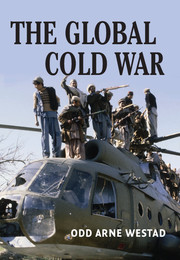Book contents
- Frontmatter
- Contents
- List of illustrations
- List of maps
- Acknowledgments
- List of abbreviations
- Introduction
- 1 The empire of liberty: American ideology and foreign interventions
- 2 The empire of justice: Soviet ideology and foreign interventions
- 3 The revolutionaries: anticolonial politics and transformations
- 4 Creating the Third World: the United States confronts revolution
- 5 The Cuban and Vietnamese challenges
- 6 The crisis of decolonization: Southern Africa
- 7 The prospects of socialism: Ethiopia and the Horn
- 8 The Islamist defiance: Iran and Afghanistan
- 9 The 1980s: the Reagan offensive
- 10 The Gorbachev withdrawal and the end of the Cold War
- Conclusion: Revolutions, interventions, and great power collapse
- Notes
- Index
4 - Creating the Third World: the United States confronts revolution
Published online by Cambridge University Press: 05 December 2012
- Frontmatter
- Contents
- List of illustrations
- List of maps
- Acknowledgments
- List of abbreviations
- Introduction
- 1 The empire of liberty: American ideology and foreign interventions
- 2 The empire of justice: Soviet ideology and foreign interventions
- 3 The revolutionaries: anticolonial politics and transformations
- 4 Creating the Third World: the United States confronts revolution
- 5 The Cuban and Vietnamese challenges
- 6 The crisis of decolonization: Southern Africa
- 7 The prospects of socialism: Ethiopia and the Horn
- 8 The Islamist defiance: Iran and Afghanistan
- 9 The 1980s: the Reagan offensive
- 10 The Gorbachev withdrawal and the end of the Cold War
- Conclusion: Revolutions, interventions, and great power collapse
- Notes
- Index
Summary
In the aftermath of World War II the United States intervened repeatedly to influence the processes of change that were taking place throughout the Third World. In some quarters in Europe (and often in the Third World itself) it became usual to speak of America replacing the European colonial powers in their struggles against anticolonial radicalism. But, as we shall see, these interventions were generally grounded in US perceptions and beliefs, and were not primarily attempts at helping out bankrupt and war-weary European powers. At the core of American Third World involvement stood the Cold War anti-Communist agenda and the exceptional interventionist capabilities that the United States possessed after the Second World War ended, a war which had made it, for the first time in its history, the dominant capitalist power, economically and militarily, as well as ideologically.
In economic terms, the US dominance was absolute, both as a reflection of American growth and because of wartime destruction elsewhere. In 1950 the US gross domestic product (GDP) was higher than all of Europe's put together, and possibly equal to that of Europe plus the Soviet Union. Its annual average growth rate since the outbreak of World War I had been almost three times that of Britain or of France, its GDP per capita was twice that of Western Europe, and productivity was almost three times the European average. And even though most of its economic growth was still concentrated at home, by 1950 the United States was by far the world's leading exporter and foreign investor.
- Type
- Chapter
- Information
- The Global Cold WarThird World Interventions and the Making of Our Times, pp. 110 - 157Publisher: Cambridge University PressPrint publication year: 2005

